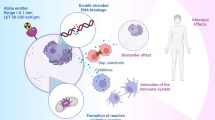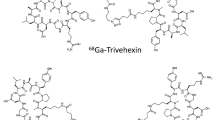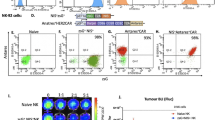Abstract
The relative biological properties of 111In-labeled monoclonal antibodies (MoAb) coupled with a conventional bifunctional chelate (BC) and a new, enzyme metabolizable, bifunctional chelate (BCM) were investigated. A rat IgG2a MoAb against idiotype from a mouse B-cell lymphoma was utilized. Mice bearing B-cell lymphomas in the subcutaneous tissues of the flank were given IV-injections of labeled MoAb and imaged or killed for organ counting at 24 h or 48 h. Rat anti-dinitrophenyl IgG2a MoAb and non-specific polyclonal mouse IgG were used as controls. Compared to BC, the use of BCM resulted in a substantial decrease in blood background activity, a shorter biological half-life and an increase in tumor to blood ratio at the expense of a moderate decrease in absolute tumor uptake. The versatile chemistry of these C-1 substituted bifunctional chelates provides a variety of possible enzyme cleavable moieties for further investigation.
Similar content being viewed by others
References
Ballow B, Levine G, Hakala T (1979) Tumor localization detected with radioactively labeled monoclonal antibody and external scintigraphy. Science 206:844–847
Barratt GM, Ryman BE, Boden JA (1981) Liposomal clearance of antibodies to tumour products: possible improvement of tumour detection. Biochem Soc Trans 9:564–565
Begent RHJ, Keep PA, Green AJ (1982) Liposomally entrapped second antibody improves tumour imaging with radiolabeled (first) antitumour antibody. Lancet 2:739–742
Bergman Y and Haimovich J (1977) Characterization of a carcinogen-induced murine B lymphocyte cell line of C3H/eB origin. Eur J Immunol 7:413
Buchegger F, Haskell CM, Schreyer M (1983) Radiolabeled fragments of monoclonal antibodies against carcinoembryonic antigen for localization of human colon carcinoma grafted into nude mice. J Exp Med 158:413–427
Burchiel SW, Khaw BA, Rhodes BA (1982) Immunopharmacokinetics of radiolabeled antibodies and their fragments. In: Tumour Imaging, the Radioimmunodetection of Cancer. Masson, New York, 125–139
Carrasquillo JA, Krohn KA, Beaumier P (1984) Diagnosis of and therapy for solid tumors with radiolabeled antibodies and immune fragments. Cancer Treat Rep 68:317–328
De Land FH, Kim EE, Simmons G (1980) Imaging approach in radioimmunodetection. Cancer Res 40:3046–49
DeRiemer LH, Meares CF, Goodwin DA (1981) Synthesis of a new tumor-visualizing derivative of Co (III) bleomycin. J Lab Comput Radiopharm 18:1517–1534
Epenetos AA, Nimmo CC, Arklie J (1982) Radioimmunodiagnosis of human cancer in an animal model using labeled tumour associated monoclonal antibodies. Br J Cancer 46:1–8
Fairweather DS, Bradwell AR, Dykes PW (1983) Improved tumor localization using Indium-III labeled antibodies. Br Med J 287:167–170
Gaffar SA, Bennett SJ, DeLand FH (1982) Carcinoembryonic antigen (CEA) radioactive antibody fragment for cancer localization in vivo. Proc Am Assoc Cancer Res 23:249
Goldenberg DM, DeLand FH, Kim EE (1978) Use of radiolabeled antibodies to a carcinoembryonic antigen for the detection and localization of diverse cancers by external photoscanning. N Engl J Med 298:1384–1388
Goldenberg DM, De Land FH, Kim EE (1980) Radioimmunodetection of cancer with radioactive antibodies to carcinoembryonic antigen. Cancer Res 40:2984–2992
Goodwin DA, Meares CF, Diamanti CI (1976) Biological properties of molecules labeled with metal ions using bifunctional chelates. In: Medical Radionuclide Imaging, IAEA Vienna 2:61–69
Goodwin DA, Meares CF, Diamanti CI (1984) Use of specific antibody for rapid clearance of circulating blood background from radiolabeled tumor imaging proteins. Eur J Nucl Med 9:209–215
Goodwin DA, Meares CF, McCall MJ (1985) Chelate conjugates of monoclonal antibodies for imaging lymphoid structures in the mouse. J Nucl Med 26:493–502
Green AJ, Begent RH, Keep PA (1984) Analysis of radioimmunodetection of tumors by the subtraction technique. J Nucl Med 25:96–100
Halpern S, Stern P, Hagan P (1983) The labeling of monoclonal antibodies with III-Indium, technique and advantages compared to radioiodine labeling. In Radioimmonoimaging. Elsevier, North Holland
Hine KR, Bradwell AR, Reeder TA (1980) Radioimmunodetection of gastrointestinal neoplasms with antibodies to carcinoembryonic antigen. Cancer Res 40:2993–2996
Jones BE, Green A, Vernon P (1982) Technical problems encountered in the use of a dual isotope background subtraction technique in antibody scanning (radioimmunodetection). Nucl Med Commun 3:124 (abstract)
Keep PA, Searle F, Begent RHJ (1983) Clearance of injected radioactively labeled antibodies to tumour products by liposome-bound second antibodies. Oncodev Biol Med 4:273–280
Kennett RH (1979) Cell fusion. In Methods in Enzymology. Academic Press, New York: pp 345–357
Kohler G, Milstein C (1975) Continuous cultures of fused cells secreting antibodies of predefined specificity. Nature 256:495–497
Kohler G, Milstein C (1976) Derivation of specific antibody-producing tissue culture and tumor lines by cell fusion. Eur J Immunol 6:511–519
Mach JP, Carrel S, Forni M (1980) Tumor localization of radiolabeled antibodies against carcinoembryonic antigen in patients with carcinoma. N Engl J Med 303:540
Mach JP, Fornim, Ritschard J (1980) Use and limitations of radiolabeled anti-CEA antibodies and their fragments for photoscanning detection of human colorectal carcinomas. Oncodevel Biol Med 1:49–69
Mach JP, Chatal JF, Lumbroso JD (1983) Tumor localization in patients by radiolabeled monoclonal antibodies against colon carcinoma. Cancer Res 43:5593–5600
Maloney DG, Kaminski MS, Burowski D Monoclonal antiidiotype antibodies against the murine B-cell lymphoma 38C13: Characterization and use as probes for the biology of the tumor in vivo and in vitro. Hydridoma: (In Press)
Meares CF, McCall MT, Reardon DT (1984) Conjugation of antibodies with bifunctional chelating agents: Isothiocynate and bromoacetamide reagents, methods of analysis and subsequent addition of metal ions. Anal Biochem 142:68–78
Meares CF, Wensel TG (1984) Metal Chelates as Probes of Biological Systems. Accounts Chem Res 17:202–209
Rainsbury RM, Westwood JH, Coombes RC (1983) Localization of metastatic breast carcinoma by a monoclonal antibody chelate labeled with Indium-III. Lancet: 934–938
Scheinberg DA, Strand M, Gansow OA (1982) Tumor imaging with radioactive metal chelates conjugated to monoclonal antibodies. Science 215:1511–1513
Scheinberg DA, Strand M (1982) Leukemic cell targeting and therapy by monoclonal antibody in a mouse model system. Cancer Res 42:44–49
Sharkey RM, Primus FJ, Goldenberg DM (1984) Second antibody clearance of radiolabeled antibody in cancer immunodetection. Proc Natl Acad Sci USA 81:2843–2846
Smedley HM, Finan P, Lennox ES (1983) Localization of metastatic carcinoma by radiolabeled monoclonal antibody. Br J Cancer 47:253–259
Stern P, Hagan P, Halpern S (1982) The effects of the radiolabel on the kinetics of monoclonal anti-CEA in a nude mouse — human colon tumor model. In Hybridomas in Cancer Diagnosis and Treatment. Raven Press, New York: 245–253
Sullivan DC, Silva JS, Cox CE (1982) Localization of I-131 labeled goat and primate anti-carcinoembryonic antigen (CEA) antibodies in patients with cancer. Invest Radiol 17:350–355
Sundberg MW, Meares CF, Goodwin DA (1974) Selective binding of metal ions to macromolecules using bifunctional analogs of EDTA. J Med Chem 17:1304–1307
Sundberg MW, Mears CF, Goodwin DA (1974) Chelating agents for the binding of metal ions to macromolecules. Nature 250:587–588
Wahl RL, Parker CW Philpott GW (1983) Improved radioimaging and tumor localization with monoclonal F(ab')2. J Nucl Med 24:316–325
Warenius HM, Galfre G, Bleehen NM (1981) Attempted targeting of a monoclonal antibody in a human tumour xenograft system. Eur J Cancer Clin Oncol 17:1009–1015
Wilbanks AB, Peterson JA, Miller S (1981) Localization of mammary tumors in vivo with 131-I labeled Fab fragments of antibodies against mouse mammary epithelial (MME) antigens. Cancer 48:1768–1775
Author information
Authors and Affiliations
Additional information
Supported in part by N.I.H. research grants CA 16861 (C.F.M.) and CA 28343 (D.A.G.) and by a grant from the Veteran's Administration
Michael K. Haseman is a recipient of the Robert Reid Newell Memorial Award
Mark S. Kaminski is a recipient of the Damon Runyan-Walter Winchell Postdoctorol Fellowship
Rights and permissions
About this article
Cite this article
Haseman, M.K., Goodwin, D.A., Meares, C.F. et al. Metabolizable 111in chelate conjugated anti-idiotype monoclonal antibody for radioimmunodetection of lymphoma in mice. Eur J Nucl Med 12, 455–460 (1986). https://doi.org/10.1007/BF00254750
Received:
Accepted:
Published:
Issue Date:
DOI: https://doi.org/10.1007/BF00254750




